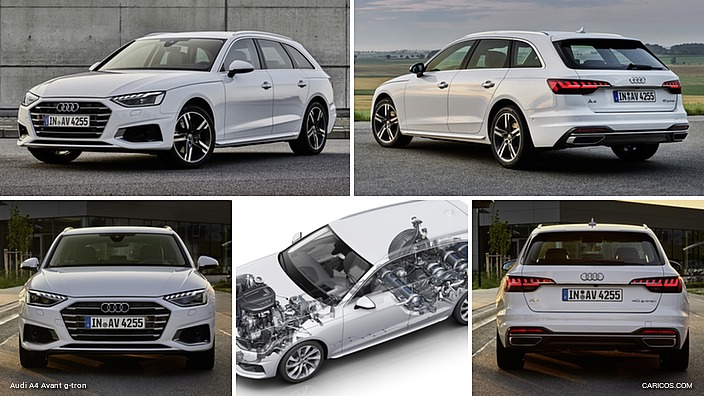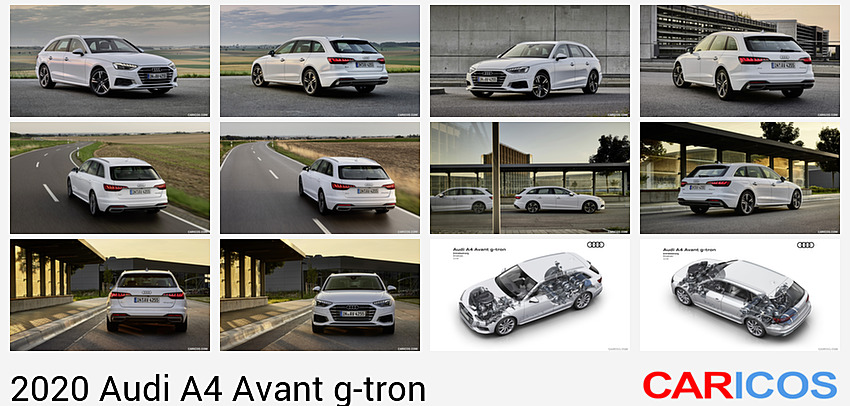Audi A4 Avant g-tron
- Low emissions and high efficiency: Natural gas as fuel protects the environment and also saves costs
- 2.0 TFSI engine with 125 kW (170 PS)
- Orders for the A4 Avant g-tron and A5 Sportback g-tron can be placed in Germany as of November 21.
Audi natural gas models combine ecology and economy: The Audi A4 Avant g-tron and A5 Sportback g-tron feature a new, sporty design and a state-of-the-art touch operating concept. Customers in Germany can order both models starting November 21 – the Audi A4 Avant 40 g-tron at a base price of EUR 43,200 and the Audi A5 Sportback 40 g-tron for EUR 45,100.
The Audi g-tron models form part of an integrated and sustainable mobility concept from the brand with the four rings. For this purpose, they use a 2.0 TFSI gasoline engine, which is specially modified for operation with CNG (compressed natural gas) and has an output of 125 kW (170 PS). The maximum torque of 270 Nm (199.1 lb-ft) is available between 1,650 and 4,400 rpm. The sprint from 0 to 100 km/h (62.1 mph) takes 8.4 seconds; the top speed for the A4 Avant g-tron is 221 km/h (137.3 mph) (Combined CNG consumption in kg/100 km: 4.1–3.9; combined CO2 emissions in g/km (CNG): 113–105* (181.9–169.0 g/mi)) and the A5 Sportback g-tron 224 km/h (Combined CNG consumption in kg/100 km: 4.1–3.8; combined CO2 emissions in g/km (CNG): 111–103* (178.6–165.8 g/mi)). A standard seven-speed S tronic transfers the drive torque of the two-liter TFSI engine to the front wheels.
 2020 Audi A4 Avant g-tron
2020 Audi A4 Avant g-tron
The four cylindrical natural gas tanks with a lightweight design, which store 17.3 kg (38.1 lb) of CNG at a pressure of 200 bar, are under the rear of the vehicle. The inner layer is a polyamide container. A second layer – a composite winding of carbon fiber-reinforced polymer (CFRP) and glass fiber-reinforced polymer (GFRP) – serves as a supporting structure with maximum strength. The outer layer consists of pure GFRP and has the task of indicating any damage that may occur as a result of stone chipping or driving over larger obstacles. Epoxy resin is used to bind the fiber-reinforced materials.
The calculated range of the A5 Sportback g-tron based on the combined natural gas consumption (NEDC) is 420 km (261.0 mi) to 455 km (282.7 mi); for the A4 Avant g-tron, it is 420 km (261.0 mi) to 440 km (273.4 mi). If the quantity of natural gas in the tanks falls below a specific value in the range 0.4 kg (0.9 lb) to 1.4 kg (3.09 lb), the 2.0 TFSI switches to gasoline operation. This depends on the CNG injection pressure and gas temperature. The filler necks for natural gas and gasoline are located under a shared tank flap.
Both revised models appear sportier and more sophisticated. In the center of the instrument panel is the large, new MMI touch display – the control center for the new operating system. Two indicators inform the driver about the fill levels of the tanks. The driver information system shows consumption in CNG or gasoline operation and, if necessary, provides information on the closest of more than 800 available CNG filling stations in Germany. The infotainment offer extends to MMI navigation plus, which is based on new hardware – the third-generation modular infotainment platform (MIB 3) Audi connect and Audi connect plus offer a host of online services, such as Car-to-X services, which take advantage of the swarm intelligence of the Audi fleet.
The Audi g-tron models of the A4 and A5 product lines can be ordered in Germany from November 21. The A4 Avant 40 g-tron is in the price list starting from EUR 43,200, and the A5 Sportback 40 g-tron is in the price list with a base price of EUR 45,100. Both models are coming to dealers in the first quarter of 2020.
Technical data on the A4 Avant 40 g-tron
| Displacement in cc | 1,984 |
| Max. power output in kW (PS) at rpm | 125 (170) from 4,450–6,000 |
| Max. torque in Nm (lb-ft) at rpm | 270 (199.1) from 1,650–4,400 |
| Top speed in km/h (mph) | 221 (355.7) |
| Acceleration 0–100 km/h (0–62.1 mph) in s | 8.4 |
| Combined natural gas consumption (NEDC) (Information for wheels from 16 to 19 inches) | 4.1–3.9 kg/100 km* |
| Natural gas range (NEDC) (Information for wheels from 16 to 19 inches) | 420 km–440 km (261.0 mi–273.4 mi) * |
| Combined CO2 emissions in CNG mode (NEDC) | 113–105 grams per kilometer (181.9–169.0 g/mi)* |










